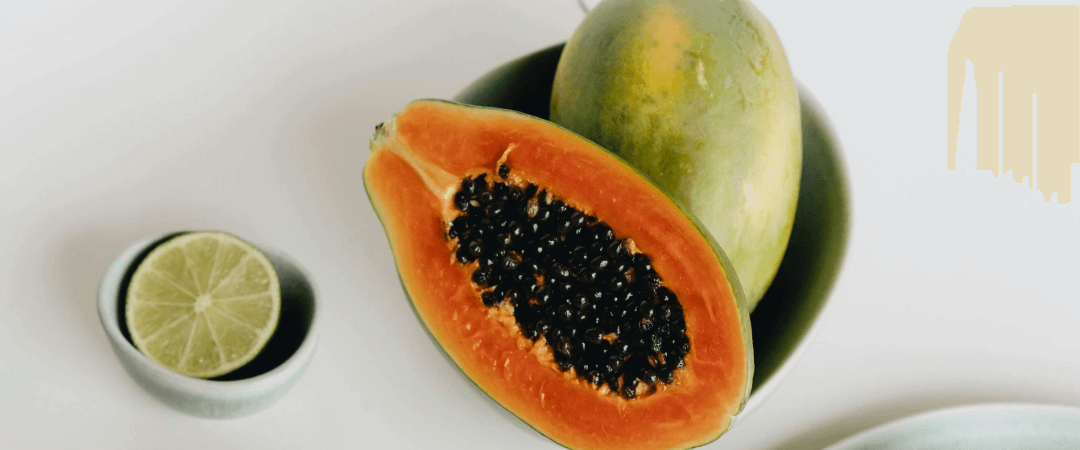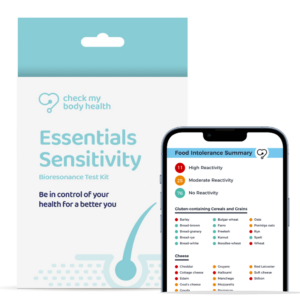
Medically reviewed by Sian Baker, Dip ION mBANT mCNHC
on April 9, 2024. To give you technically accurate, evidence-based information, content published on the Check My Body Health blog is reviewed by credentialed professionals with expertise in medical and bioscience fields.
A papaya allergy is when you experience symptoms after eating papaya or food containing papaya. Symptoms can be unpleasant, ranging from itchy skin to stomach pain. Serious allergies can cause breathing difficulties or anaphylaxis, but thankfully this is rare. In this post, we’re going to explore the signs and symptoms of papaya allergies, how common they are, and what food to avoid if you suspect you suffer from one.
Can you be allergic to papaya?
Yes, it is possible to be allergic to papaya. As with any food allergy, the body’s immune system mistakenly identifies a specific substance in papaya as harmful, triggering an allergic reaction.
How common is a papaya allergy?
While not as common as allergies to foods like nuts or shellfish, papaya allergy can occur. The prevalence can vary by region, especially in areas where papaya is more commonly consumed.
Signs & Symptoms of a Papaya Intolerance or Allergy
The symptoms of a papaya allergy can vary from mild to severe and may include:
- Nausea, sickness, or diarrhoea
- Hives, rash, or itchy skin
- Abdominal pain and cramps
- Breathing difficulties or tightening of the throat
- Pale or discoloured skin
- Lightheadedness or dizziness
In some cases, an individual may experience anaphylaxis, a severe and potentially life-threatening reaction. It’s important to note that you don’t need to eat papaya to experience symptoms; exposure to the fruit in environments where it’s being prepared or processed can also trigger an allergic reaction.
What are the symptoms of a papaya intolerance?
Intolerance to papaya, while less severe than an allergic reaction, can still cause discomfort and include symptoms like:
- Stomach or intestinal pain
- Bloating
- Constipation or diarrhoea
- Fatigue
What is food intolerance?
A food intolerance occurs when the body struggles to digest a particular food. This condition does not involve the immune system but results from difficulty metabolising certain food compounds, leading to symptoms that, although uncomfortable, are usually not life-threatening.
How do you test for a papaya allergy or intolerance?
To determine if you have a papaya allergy or intolerance, consider the following steps:
- Keep a food diary to track your intake and note any symptoms following consumption of papaya.
- Try an elimination diet by removing papaya from your diet to see if symptoms improve.
- Consider a food intolerance test, which can identify allergies or intolerances to papaya and other foods.
What foods should you avoid if you have a papaya allergy or intolerance?
If you’re allergic or intolerant to papaya, it’s important to avoid:
- Fresh papaya
- Papaya in fruit mixes or salads
- Papaya extracts found in some foods and beverages
- Papaya enzymes commonly used in meat tenderisers and chewing gums
Knowing what you’re eating and carefully reading labels is essential to avoid accidental exposure.
10 Alternatives to Papaya
If you’re allergic or intolerant to papaya, consider these alternatives that can provide similar nutritional benefits without the risk of an allergic reaction:
- Mango – Offers a similar tropical flavour and rich in vitamins A and C.
- Cantaloupe – A sweet melon that can substitute for papaya in salads and smoothies.
- Peaches – Provide a juicy, sweet taste and can be used in many recipes calling for papaya.
- Papaya Seed Oil (for those not allergic to the seeds) – Can be used in cosmetic products as an alternative to papaya extract.
- Berries – Strawberries, blueberries, and raspberries offer antioxidants and can be used in desserts and salads.
- Bananas – A versatile fruit that can replace papaya in smoothies and baking.
- Avocado – Though not similar in taste, it’s a great alternative for the texture in salads and smoothies.
- Kiwi – Offers a vibrant green colour and a unique taste that can be a good substitute in fruit salads.
- Pineapple – Provides a tropical flavour that works well in dishes where papaya is used.
- Watermelon – Has a high water content and can be a refreshing alternative in fruit salads.
FAQs on Papaya Allergy
Can a papaya allergy go away over time?
Some children may outgrow their food allergies, but adults with a papaya allergy are less likely to see it diminish over time. Regular check-ups with an allergist can help monitor any changes.
Is it safe to use skincare products containing papaya?
If you have a papaya allergy, it’s best to avoid skincare products with papaya extracts as they can potentially cause skin reactions. Always patch-test a new product before widespread use.
Can cooking destroy the allergens in papaya?
Cooking can alter some food allergens, but it’s unlikely to completely eliminate the risk for those with a papaya allergy. It’s safest to avoid papaya completely.
Are there any cross-reactivities with papaya allergy?
Individuals with a papaya allergy may also react to other latex-containing fruits like avocados, bananas, and kiwis, a condition known as latex-fruit syndrome. Consult an allergist for testing if you suspect cross-reactivities.
Remember, managing a food allergy or intolerance is about making informed choices and taking precautions to avoid exposure. If you think you have a papaya allergy or intolerance, consider trying one of our food intolerance tests for a comprehensive understanding of your dietary restrictions.




